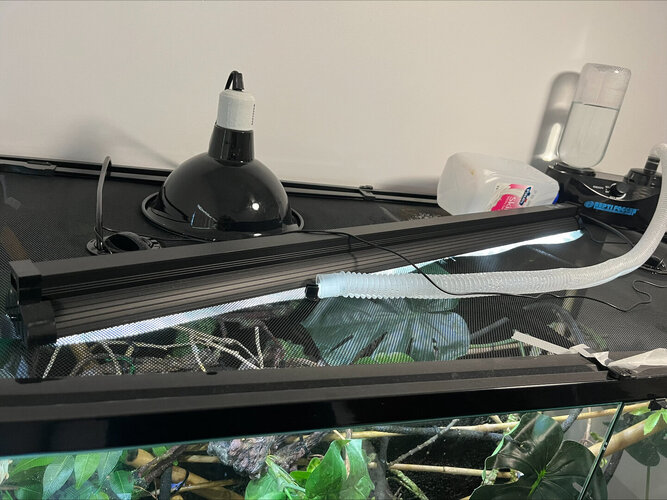Yeahna
New Member
Hi everyone,
I'm starting to get a bit worried about my little man Miso.
He has been doing really well up until the last week where his eating has slowed down dramatically.
I usually feed 10-12 small crickets and most would get eaten, not i am finding 8/10 alive every evening still.
Its not like he cant find them, often he will be right next to them or walk straight over them when he goes on his little adventures. He is just not interested.
I got some meal worms to mix up his diet a bit, which he was thrilled with for a couple of days.
Now he is no longer interested.
His poop and urates look fine, but are extremely small, which obviously indicates he isn't eating much.
Any advice is much appreciated.
Your Chameleon
Cage Info:
I'm starting to get a bit worried about my little man Miso.
He has been doing really well up until the last week where his eating has slowed down dramatically.
I usually feed 10-12 small crickets and most would get eaten, not i am finding 8/10 alive every evening still.
Its not like he cant find them, often he will be right next to them or walk straight over them when he goes on his little adventures. He is just not interested.
I got some meal worms to mix up his diet a bit, which he was thrilled with for a couple of days.
Now he is no longer interested.
His poop and urates look fine, but are extremely small, which obviously indicates he isn't eating much.
Any advice is much appreciated.
Your Chameleon
- Species: Veiled Chameleon
- Sex: male
- Age: 4 months
- Been in my care for 2 months
- Handling
- I only have handled him on rare occasions. A couple time ive put my finger out and he will climb on and walk up my shoulder and ill put him back.
- Feeding
- Feeding: 8-10 small crickets per morning
- Gut loading: carrots, oranges, other greens
- Supplements
- Reptile one calcium - every feeding
- Reptile one calcium with D3 - once a fortnight
- Vitamin A - once a month
- Watering
- Mist: Exo Terra Monsoon - 2 nozzles
- 8am, 9pm, 1am, 4am, for 2 minutes
- Fogger: ReptiFogger
- 1am to 6am - turns on and off to keep humidity at desired level
- Dripper: Homemade. Its just a empty drink bottle with a pin prick in the side that drips onto a large leaf - very accesable to where he spends most of his time
- Drinking: i have never seen him drink
- Mist: Exo Terra Monsoon - 2 nozzles
- Fecal Description
- Urate: White and moist - VERY SMALL
- Poop: Moist - VERY SMALL
- I compared the droppings to pics in one of the forums on this site
- Parasites: Chameleon has not been tested for parasite
Cage Info:
- Cage Type
- Glass sides, screen top - 120x60x100cm
- Lighting
- UVB: Get your pet right LED UVB Bar 7.0 - 9 watt
- Schedule: 7am - 7pm
- Temperature
- Heat Lamp: Dome Reflector Ceramic Suit Up To 100w E27 Screw Fitting 22cm
- Bulb: Ceramic heat emitter - 75 watt
- I used to use a daylight heat bulb but found it wasnt warming the enclosure sufficiently
- I measure basking temp with a laser temp gun and ambient with a temp probe
- basking is about 30 degrees (7am-7pm)
- ambient is about 23 degrees in the day and 15 at night (heat emitter will come back on if temp drops past 13 at night emitter will come back on until temp reaches a max of 18 - as there is no light)
- Humidity
- Measure humidity with probe
- Day time is about 50-60%
- Night time is 90-100%
- I turn fan on in the morning over top of enclosure which brings the humidity down a bit quicker for about 1 hour
- Create humidity using fogger and mister
- Plants
- Umbrella tree
- Golden Pothos
- Devils Ivy
- Fake plants
- Placement
- Enclosure is in spare room of house - gets nearly no traffic at all
- The enclosure is on a stand that is also 120 cm tall - so the top of enclosure stands 220 from ground
- No vents, fan overhead which only comes on when i put it on to increase airflow in enclosure







